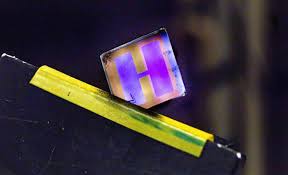
Breaking News
 As Trump sets eyes on Greenland, Europe scrambles to make plan to tackle US aggression
As Trump sets eyes on Greenland, Europe scrambles to make plan to tackle US aggression
 Corporation for Public Broadcasting votes itself out of existence
Corporation for Public Broadcasting votes itself out of existence
 John Leake on Vaccines: The Demonic Rituals to Replicate God and Mankind's New Religion...
John Leake on Vaccines: The Demonic Rituals to Replicate God and Mankind's New Religion...
 US Farmers Began Using Chemical Fertilizer After WW2. Comfrey Is a Natural Super Fertilizer
US Farmers Began Using Chemical Fertilizer After WW2. Comfrey Is a Natural Super Fertilizer
Top Tech News
 The First Production All-Solid-State Battery Is Here, And It Promises 5-Minute Charging
The First Production All-Solid-State Battery Is Here, And It Promises 5-Minute Charging
 See inside the tech-topia cities billionaires are betting big on developing...
See inside the tech-topia cities billionaires are betting big on developing...
 Storage doesn't get much cheaper than this
Storage doesn't get much cheaper than this
 Laser weapons go mobile on US Army small vehicles
Laser weapons go mobile on US Army small vehicles
 EngineAI T800: Born to Disrupt! #EngineAI #robotics #newtechnology #newproduct
EngineAI T800: Born to Disrupt! #EngineAI #robotics #newtechnology #newproduct
 This Silicon Anode Breakthrough Could Mark A Turning Point For EV Batteries [Update]
This Silicon Anode Breakthrough Could Mark A Turning Point For EV Batteries [Update]
 Travel gadget promises to dry and iron your clothes – totally hands-free
Travel gadget promises to dry and iron your clothes – totally hands-free
 Perfect Aircrete, Kitchen Ingredients.
Perfect Aircrete, Kitchen Ingredients.
 Futuristic pixel-raising display lets you feel what's onscreen
Futuristic pixel-raising display lets you feel what's onscreen
 Cutting-Edge Facility Generates Pure Water and Hydrogen Fuel from Seawater for Mere Pennies
Cutting-Edge Facility Generates Pure Water and Hydrogen Fuel from Seawater for Mere Pennies
Indoor Solar Cells That Can Generate Electricity From Home Lighting Could Power All Our...

Swedish and Chinese scientists have developed a new kind of organic solar cell that has been optimized to convert ambient indoor light into electricity.
The power they produce is low, but is probably enough to feed the millions of products that the internet of things will bring online.
As the internet of things expands, it is expected that we will need to have millions of products online, both in public spaces and in homes. Many of these will be the multitude of sensors to detect and measure moisture, particle concentrations, temperature and other parameters. For this reason, the demand for small and cheap sources of renewable energy is increasing rapidly, in order to reduce the need for frequent and expensive battery replacements.
This is where organic solar cells come in. Not only are they flexible, cheap to manufacture and suitable to manufacture as large surfaces in a printing press, they have one further advantage: the light-absorbing layer consists of a mixture of donor and acceptor materials, which gives considerable flexibility in tuning the solar cells such that they are optimized for different spectra—for light of different wavelengths.
Researchers in Beijing and Linköping, led by Jianhui Hou and Feng Gao, have now developed a new combination of donor and acceptor materials, with a carefully determined composition, to be used as the active layer in an organic solar cell. The combination absorbs exactly the wavelengths of light that surround us in our living rooms, at the library and in the supermarket.
The researchers describe two variants of an organic solar cell in an article in Nature Energy, where one variant has an area of 1 cm2 and the other 4 cm2. The smaller solar cell was exposed to ambient light at an intensity of 1000 lux, and the researchers observed that as much as 26.1% of the energy of the light was converted to electricity. The organic solar cell delivered a high voltage of above 1 V for more than 1,000 hours in ambient light that varied between 200 and 1000 lux. The larger solar cell still maintained an energy efficiency of 23%.
"This work indicates great promise for organic solar cells to be widely used in our daily life for powering the internet of things," says Feng Gao, senior lecturer in the Division of Biomolecular and Organic Electronics at Linköping University.
Jianhui Hou, professor at the Institute of Chemistry, Chinese Academy of Sciences, added: "We are confident that the efficiency of organic solar cells will be further improved for ambient light applications in coming years, because there is still a large room for optimization of the materials used in this work."
The result is a further advance in research within the field of organic solar cells. In the summer of 2018, for example, the scientists, together with colleagues from a number of other universities, published rules for the construction of efficient organic solar cells (see the link given below). The article, which involved 25 researchers from seven universities led by Feng Gao, was published in Nature Materials. These rules have proven to be useful along the complete pathway to efficient solar cell for indoor use.



